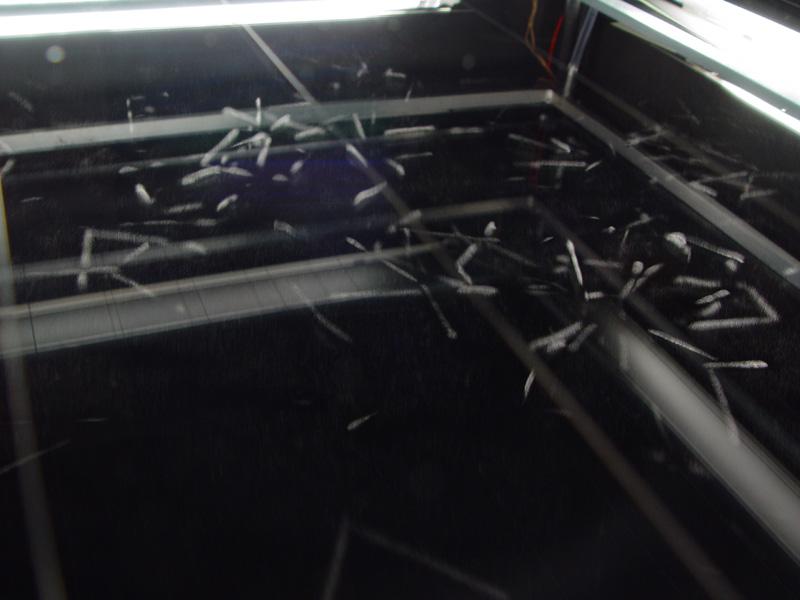Putting the threat into perspective

Nebelkammer,
Uni Regensburg
See also my essays on
nuclear
energy
and Lernprozesse
M. Goldman (1996) Cancer risk of low-level exposure. Science 271: 1821-2
Putting the threat into perspective |
 Nebelkammer,
Uni Regensburg |
| It is not known if any creature living on our earth has a sensory organ to detect radioactivity. Human beings are definitely not capable of detecting fast traveling particles (with the notable exception of photons in the visible energy range). Nevertheless, these particles are relatively easy to detect, by man-made instruments. Since more than 25 years, such an instrument is at my disposition. It is a hand-held b-g-detector with a window measuring 10 x 10 cm. If switched on, it reports the unabating influx of radiation, producing 10-20 ticks per second. |
| My former bosses always told me, I shouldn't worry about these signals. They called this background radiation, cosmic radiation, earth radiation, a composite of all these. They even explained to me that in our own bodies several thousand 40K nuclei would decay per second. It has been estimated that this 40K accounts for 20-30% of the total background radiation dose that living organisms accumulate. But it has also been shown, that at least the bacterium Escherichia coli is not influenced in its mutation rate, neither by the omission of 40K, nor by increasing 40K content from naturally 0.012 to 80% (Gevertz et al. 1985). |
| When I visited the last time the Vienna Technical Museum, I was very impressed by Wilson's Nebelkammer (I found it on the ground floor, left side). I advise the visit of this wonderfully black table to all colleagues exposed to radiation during their research activities. I stood there at least for 30 min, watching with fascination the trajectories that constantly appear and disappear in the water-saturated atmosphere. These particles are on their ways all the time, day and night, Sundays included. They don't care if a living body is in their way. |
| In May 86, my interest in our hand-held b-g-detector increased sharply, when I discovered my shoe soles emitting more than 100 impulses per second. Subsequently, I discovered this and higher activities outside in the open, everywhere. I began to measure radioactivity in milk, and I found it even there. For the rest of 86, I measured radioactivity (mostly 137Cs) in more than 1000 milk samples; the compiled data were published monthly in the "Falter", in cooperation with the then newly founded Austrian Ecology Institute. In most samples, the 137Cs content surpassed the natural 40K content. Since then, I fear nuclear power plants more than labeled experimental compounds. |
| Since Hiroshima & Nagasaki, several attempts have been made to estimate the health risks associated with exposure to radiation. Contamination of great parts of Europe in 86, after the Chernobyl power plant accident, have rekindled this debate, however, still no definite conclusions emerge. In a 1996 Science commentary, Marvin Goldman cites a United Nations investigation on 'Sources and effects of ionizing radiation' (1994), stating that cancer mortality is not increased in populations exposed to higher natural background radiation. |
| Nevertheless, let's assume the worst case for a simple thought experiment. Let's assume that ALL cancers were caused by radiation. If this were true, our cancer risk would increase in proportion to the number of particles impacting on our body, what ever the source might be. Most cancers appear at advanced age, after e.g. 70 years of continuous particle bombardment. Given a background flux of 10 - 20 particles per second and 10 x 10 cm2, a 70 years old human would have suffered 22 - 44 x 109 such impacts per 100 cm2. If she/he was exposed for e.g. 100 h to radiation 10 times above background, this would increase her/his burden by 0.2%. |
| To avoid significant exposures, each radiation worker is supervised by carrying on her/his body a detector, that is sensitive enough to record even background radiation. As long as I have known the record as a radiation officer of our institution, I have seen nobody's detector in any month recording more than this natural background, although such grim isotopes as 32P, 131I and 54Mn have been handled. However, also these detectors are exposed to background radiation for 720 h per month (like us when we feel safe at home). If we add a few hours per month with 2-3 times increased radiation, neither these detectors nor our bodies will recognize the difference. |
| I do not say this to encourage careless handling of radioactive compounds; but sometimes exaggerated fear of a threat can do more harm then the threat itself. |
| 6/07 < MB (9/07) > 1/08 |
See also my essays on
nuclear
energy and Lernprozesse |
|
D. Gevertz, A.M. Friedman, J.J. Katz, H.E.
Kubitschek (1985) Biological effects of background radiation: Mutagenicity of
40K. Proc. Natl. Acad. Sci. USA 82: 8602-5.
M. Goldman (1996) Cancer risk of low-level exposure. Science 271: 1821-2 |